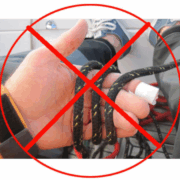SAIL TRIM – HOW DO SAILS WORK?
How a sail works and moves a boat forward becomes second nature to experienced sailors, but if you’ve never sailed before, it’s overwhelming. In fact, kind of like flying in an airplane, you might know there’s some science involved, but you’re not in charge of said science, so you’re okay with thinking, “I’m not sure how this works, but it works, so I’m not going to give it another thought.”
And then you see someone sailing somewhere exotic in a movie or you go out on your friend’s sailboat and you start getting curious. Okay, it feels like the wind is kind of coming from beside us, but we’re moving forward. That’s weird. Hmm, she just pulled on some lines and moved the sails and now we’re going way faster. Umm… all of a sudden, the sails are freaking out and waving around like one of those inflatable guys at a car lot. Okay, I have to know how this works.
We’re going to talk a little bit about sail trim, but if you’re new to sailing, we highly recommend you check out our first two online sailing courses. They are free and include all kinds of interactive graphics to help you really get the hang of this.
We’re going to talk a little bit about sail trim, but if you’re new to sailing, we highly recommend you check out our first two online sailing courses. They are free and include all kinds of interactive graphics to help you really get the hang of this.
Three basic ways to harness the wind
If we take sailing down to its most basic components, you’re trying to use wind (apparent wind actually) to move your boat somewhere. There are three tools you have to do this (and do it efficiently):
-
- The angle of your sails – The angle of your sails in relation to where the wind is coming from gives you the most control. You’re aiming for smooth air flowing over your sails to create lift (but more on that later).
- The direction of your boat – Because the wind is such a fickle friend and your boat/sails will have limitations, there are moments when you can’t go in a straight line to your desired destination. How your boat is facing in relation to where the wind is coming from (how many degrees off the wind you are – in sailing speak) will impact your motion.
- The shape of your sails – This is literally the shape of a sail when it is filled with air. We use things like halyards, sheets, outhauls, Cunninghams, and fairleads, etc. to control this shape and try to make it as big as possible within the limitations of the first two factors/tools on this list.
How do sails move a sailboat
Here we go. Sails really do act kind of like an airplane wing. As air travels across a sail, some air goes over and some goes under. The air going “over” the sail pulls or lifts the sail (and boat) forward while the wind moving “under” the sail fills and pushes the sail and the boat forward. How much lifting and how much pushing is going on depends on a lot, but that’s the gist of how it works. There’s basically no way to explain this without an illustration, so here’s a good one (Pst! We love illustrations and can expect lots of them in our courses).
What’s turbulent airflow?
As you’re sailing, you’re always aiming to keep air flowing over the sails smoothly — smooth airflow equals efficient sailing. Turbulent airflow happens when the sail isn’t at an optimum position and the wind essentially can’t “stick” to the sail as it moves across. The angle of the sail is too great and the wind starts “detaching” from the sail as it moves. Basically, it “can’t make the corner”. As you’d probably expect, wind detaching from your sail slows you down. Instead, your sails should be set at such an angle so the air flows smoothly over the lifting side of the sail, staying attached as it flows and pulls the boat forward.
How can you tell if your sail is trimmed correctly?
All sailors probably wish, at one point or another, that they could clearly see the wind, but alas, we need to rely on seeing the effect of the wind in order to “see” whether the wind is moving over your sails correctly. Thankfully for us, we have telltales. These are little strips of ribbon, string, or threads of wool (sometimes called woolies) mounted on each side of the sail (red on port, green on starboard). If these telltales are flying smoothly backward, like a dog’s fur when its head is sticking out a car window, you’ve trimmed your sails well. If they are flapping, this means that there’s some turbulence and the wind is detaching from the sails. The sails need to be adjusted.
Basic sail trim to control telltales
The general rule is to move your sail towards the flapping telltale. For example, if your red telltale (the one on the port side) is flapping wildly, you need to move that sail a little more toward the port side. If the green one is flapping, move the sail toward the starboard side until it smooths out.
Adjusting your tack (direction) to control telltales
Because wind is never consistent (can you imagine if it were?!), sometimes turning your boat (making a course adjustment) a little is all you need. When a telltale is flapping, it’s really just saying, “I need more wind!” so, steer your boat to expose that telltale to more wind (turn away from the flapping telltale so it gets more wind). Give the people what they want!
Adjusting your sail shape to control telltales
Sail shape isn’t necessarily any more complicated than the tools we’ve already discussed, but it certainly involves a lot of sailing terminology and a little more information. This is the perfect spot to stop and direct you to our free online sailing education courses. They are broken down into modules so the information doesn’t get too overwhelming and there are both interactive animations and quizzes to really make sure everything is sinking in (no pun intended).







